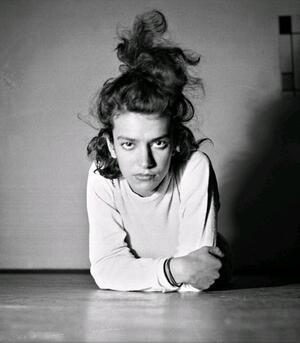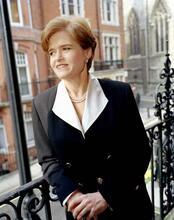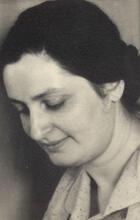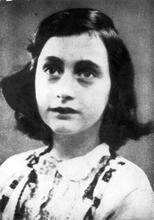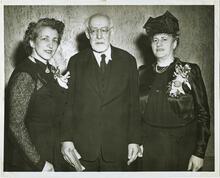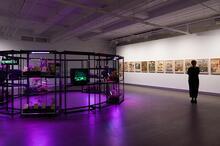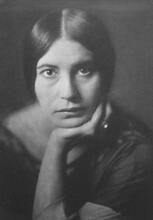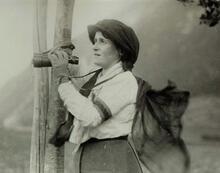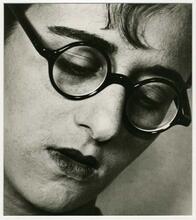Eva Besnyö
Photographer and photojournalist Eva Besnyö was born in Budapest on April 29, 1910. In 1928 she began studying at the renowned József Pécsi Portrait, Advertising and Architecture Studio. In 1930 Besnyö moved to Berlin, began working with photographer Dr. Peter Weller, and became part of a circle of politically engaged intellectuals and artists. In 1931 she established her own studio, but her success was interrupted by the Nazi rise to power and she ultimately went underground. Following the war, Besnyö was active in the Dolle-Mina feminist movement and her photographs became the chronicler of its events. In 1999, Besnyö was awarded the Dr. Erich Salomon Award for her life’s work; at the end of the same year, the Stedelijk Museum held an exhibition of her work.
Early Life and Family
Photographer and photojournalist Eva Besnyö was born in Budapest on April 29, 1910. Her father, Bernat Besnyö, a lawyer, was born in 1877 and killed in Auschwitz in 1944. Her mother Ilonka, née Kelemen, was born in 1883 and died in 1981. Raised in a liberal Jewish home, Eva grew up knowing both German and Hungarian. Her father’s wish that she continue studying after completing high school was not to her liking; she wanted to become a photographer. Thus in 1928 she began a two-year course of studies at the renowned József Pécsi Portrait, Advertising and Architecture Studio, where she also did her apprenticeship. In 1930 she decided to move to Berlin, metropolis of the avant-garde, not only in order to get away from home but also in order to leave the Hungary of the Horthy regime. Later she referred to her stay in Berlin as the most important period of her life, meaning that it laid the foundations not only of her photographic practice but also of her political awareness.
She worked for a short time in the laboratory of the advertising photographer René Ahrlé until she found more interesting employment with the press photographer Dr. Peter Weller, for whom she did photoreportage on everyday themes. As was customary at the time, these appeared under his name in the Berliner Illustrirten Zeitung. When she was permitted to choose her own topics, she simply went out on the streets, where she always found what interested her. She became part of a circle of socially and politically engaged intellectuals and artists such as György Kepes, Joris Ivens, John Fernhout, Lászlo Moholy-Nagy, Otto Umbehr (Umbo), Robert Capa and others, attended the Marxist Workers’ Evening Courses, went to productions by Erwin Piscator and was fascinated by Russian film.
Photography Career
In 1931 she seized an opportunity to become independent by establishing her own studio. Commissions and work for the Neofot Picture Agency brought her success, which was however soon interrupted: early on she became aware of the growing threat of National-Socialism and in the autumn of 1932 she decided to move to Amsterdam with her Dutch companion, the cameraman John Fernhout, with whom she lived until 1939. With the help of the artist Charley Toorop, she soon found her feet in Holland and the recognition she won by her exhibitions led to numerous commissions in the fields of photoreportage, portraits, fashion and architecture. In 1934 she became a member of the association of artists for the defense of cultural rights. In this capacity she participated in the association’s 1936 protest exhibition against the Berlin Olympic Games, the “Olympics under Dictatorship” and organized the internationally-oriented exhibition “Foto ’37” at the Stedelijk Museum in Amsterdam, intended to enhance awareness of photography as an art form.
After the capitulation of the Netherlands army in May 1940, as the conditions of Jews steadily deteriorated, Eva Besnyö was forbidden to engage in all journalistic activities. In 1942, when her sole source of income was a few private commissions, she went underground for two years. After the war she received numerous commissions for photo-documentation and remained professionally active, though she was now the mother of a son (born in 1945) and a daughter (born in 1948), fathered by the graphic designer Wim Brusse, from whom she separated in 1968.
Later Life and Career
From 1970 to 1976 Eva Besnyö was active in the Dolle-Mina feminist movement for women’s rights and through her photographs became the chronicler of events. In 1980 she rejected the Ritterorden (knighthood) that was to have been bestowed on her by the Queen of the Netherlands. In 1999, in Berlin, the “grand old lady” of Dutch photography was awarded the Dr. Erich Salomon Award for her life’s work and at the end of the same year the Stedelijk Museum held an exhibition of her work.
Eva Besnyö died in Laren, Netherlands on December 12, 2002.
Solo Exhibitions by Eva Besnyö
N’halve eeuw werk. Amsterdams Historisch Museum. Amsterdam: 1982.
Onbekende foto’s. Jewish Historical Museum. Amsterdam: 1991.
Photographien 1930–1989. Das Verborgene Museum. Berlin: 1992.
Vintage Prints. Amsterdams Historisch Museum. Amsterdam: 1994.
Diepraam, Willem. Eva Besnyö, Monografieen van Nederlandse fotografen. Focus Uitgeverij, Prins Bernhard Cultuurfonds. Amsterdam: 1999.
Eva Besnyö, n’halve eeuw, Feministische Uitgeverij Sara. Amsterdam: 1982.
Eva Besnyö, Photographien 1930–1989. Das Verborgene Museum. Berlin: 1992.
Lexikon Jüdische Frauen. Edited by Jutta Dick and Marina Sassenberg.
Seren, M. do Carmo. Eva Besnyö, Una retrospectiva. Centro Portugues de Fotografia. Porto, Portugal: 1999.

